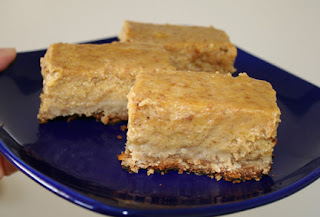I made and canned these luscious jam-type banana sweets two weeks ago but never got around to taking the photos until this evening. I've loved making different edibles out of the crates of bananas that I was very fortunate to be able to purchase for such pocket change. I'm NOT going to miss the amazing swarms of fruit flies that manage to invade our house, though.
The Lemon Banana Preserves turned out to be a very pretty pink color. I didn't add the yellow food coloring to this batch. The consistency is like chunky applesauce. It's very nice on toast.
Lemon Banana Preserves

Prep Time: 15 mins
Total Time: 45 mins
8 bananas, firm but ripe and mashed
3 lemons, juice of
3 1/2 cups sugar
4 1/2 cups water
1 1/2 teaspoons pureed gingerroot
2 dashes salt
8 whole cloves
2 drops yellow food coloring (optional)
Directions:
In large dutch oven, add sugar and 3 1/2 cups water, cloves and ginger.
Note: You can use small pieces of ginger root but it must be removed before packing jars.
Cook on low heat and stir occasionally.
Remove rind (lemon zest) with peeler or a zester and add very small pieces or strips to the cooking sugar, water and spice mixture.
Use all of the rind on one lemon.
Add to the pan.
Juice all of the lemons and add the juice and if desired add chopped lemon pulp.
DO NOT USE THE WHITE PORTION WHICH HOLDS THE PULP. IT IS VERY BITTER.
Mash the bananas.
The mixture should have been simmering about 10 minutes. Stir so the mixture does not scorch and burn.
Add 1 cup water. Stir.
Take out the cloves and ginger pieces (if you didn’t use pureed ginger.)
Add the mashed bananas.
Add yellow food coloring.
Stir. Cook about 6 minutes on low heat. The preserves should be the consistency of thick applesauce. If it is too thin, add another mashed banana.
16. Wash 8 half pint jars, with hot soapy water, rinse and place in 9 X 13 pan with water, set in 275* oven to heat and sterilize. Turn the washed jars upside down so that the hot water in the pan is around the rims and up the sides a little. Heat seals and rings in water in a saucepan on the stove.
Pack in jars. Make sure you wipe the rim of the jars after packing. Place hot seal on jar and then ring. Tighten.
Make sure the water is boiling before placing in the water bath.
Water bath for 10 minutes.
Note: If you are at high altitude above 4,000 feet, add another 10 minutes to the water bath boiling time.
I was surprised to find this Banana Butter ending up with a very light yellowish color. I KNOW that bananas are supposed to be yellow, but I guess I was thinking they'd be more like apple butter - dark. This stuff is also very nice on toast. It's very sweet.
Banana Butter
Difficulty: Moderately Easy
Instructions
• 16 medium sized bananas (very ripe)
• 1/2 cup pear juice
• 1/2 cup lemon juice
• 4 cups of granulated sugar
• 1 TBSP unsalted butter
• 1 (3oz.) pkg. of powdered pectin
• 1 tsp. nutmeg
• 1 tsp. cinnamon
• 1 tsp. ground cloves
1. Peel bananas and mash them in a large pot. Add pear juice, and bring to a boil. Reduce the heat, stirring constantly. Simmer 30 minutes.
2. Run the banana mixture through a sieve. Return the banana mixture to the pan. Now you want to add the butter, and seasonings. Stir till blended. Add lemon juice, and sugar. Bring the mixture back to a boil, stirring constantly. Once all the sugar is dissolved, add the pectin.
3. Continue stirring, and reduce the heat. Stirring is important because you don't want to burn or scorch the mixture. Simmer for another 30 minutes. Be sure to skim off any foam that appears. Mixture will begin to thicken, and become creamy.
4. If you want to preserve the butter by canning, spoon warm butter into sterile canning jars and process 15 minutes. (Boiling water bath) This will make about 7 half pint jars. Any butter you want to keep out can be refrigerated for up to 10 days.


























































